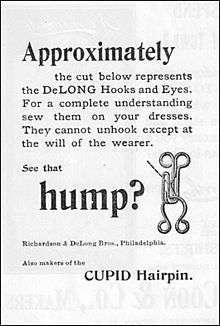Hook-and-eye closure
A hook-and-eye closure is a very simple and secure method of fastening garments together. It consists of a metal hook, commonly made of flattened wire bent to the required shape, and an eye (or "eyelet") of the same material into which the hook fits.
History
The hook and eye closure has a long history and is still used today, primarily on bras.
This form of fastening first appears under the name of "crochet and loop" in 14th century England.[1]
The first reference to the modern term appears in Aubrey's Brief Lives in 1697, which describes a doublet and breeches being attached with "hook and eies".[2] Hooks and eyes were made by hand from wire, until the city of Redditch, England, already famous for needle manufacture, was the first to machine-manufacture them. In 1643 a woman in the American colony of Maryland is recorded to have paid £10 worth of tobacco for hooks and eyes.[3]
The hook and eye played an important role in women's corsetry; used in rows, they distribute the stress involved in restrictive garments.
It was not until the first part of the 19th century that the industry was furthered in the United States. One of the greatest improvements in the attachment was the "Delong hump", patented in 1889 by the Richardson & Delong Hook and Eye Company of Philadelphia, Pennsylvania which was a raised elevation or "hump" in the wire hook that prevented the eye from slipping out of the hook, "except at the will of the wearer".[4]

In 1893, Marie Tucek patented the "Breast Supporter" – the first garment similar to the modern-day bra, which used separate pockets for the breasts and straps that went over the shoulder and fastened by hook-and-eye closures to the center front of the garment.[5]
E.C. Beecher patented his hook-and-eye in June 1900 with the U.S. Patent Office; in 1902, an updated version was submitted that consisted of an attachable hook-and-eye, without any stitching required.[6] A similar hook and eye for brassieres was patented in 1902 by the M.E. Company.[7]
The fasteners were eventually manufactured in the form of hook-and-eye tape, consisting of two tapes, one equipped with hooks and the other equipped with eyelets so that the two tapes could be "zipped" together side-by-side. To construct the garment, sections of hook-and-eye tape were sewn into either side of the garment closure. Today this labor-saving method comes on either silk or cotton tape, depending on the firmness and strength needed.
In addition to their application on brassieres, bustiers, corsets and other fine lingerie, a single hook-and-eye closure is often sewn above the top of the zipper to "finish" it and take stress off the fastening on a skirt, dress or pants. They are generally provided at one gross to a box and range in size from No. 1 small, to No. 10 large.
References
- ↑ George S. Cole, A Complete Dictionary of Dry Goods, Chicago, W. B. Conkey company, 1892
- ↑ Page, John Aubrey, Aubrey's Brief Lives, David R Godine, 1999
- ↑ Souder, Mary Attie, Notions, The Ronald Press Company, 1922, p.121
- ↑ Souder, Mary Attie, Notions, The Ronald Press Company, 1922, p.120
- ↑ Bellis, Mary, The History of the Brassiere: Mary Phelps Jacob and the Brassiere, about.com
- ↑ USPTO, Patent# 652160, 1900 June
- ↑ USPTO, Patent# 662539, 1990 Nov